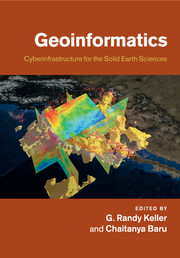Book contents
- Frontmatter
- Contents
- List of contributors
- Preface
- Introduction
- Part I Case studies from other disciplines
- Part II Modeling software and community codes
- Part III Visualization and data representation
- Part IV Knowledge management and data integration
- 10 Data and tools for geologic timelines and timescales
- 11 Modeling geodynamic processes with ontologies
- Part V Web services and scientific workflows
- Part VI Emerging international and other efforts
- Index
- Plate section
- References
11 - Modeling geodynamic processes with ontologies
from Part IV - Knowledge management and data integration
Published online by Cambridge University Press: 25 October 2011
- Frontmatter
- Contents
- List of contributors
- Preface
- Introduction
- Part I Case studies from other disciplines
- Part II Modeling software and community codes
- Part III Visualization and data representation
- Part IV Knowledge management and data integration
- 10 Data and tools for geologic timelines and timescales
- 11 Modeling geodynamic processes with ontologies
- Part V Web services and scientific workflows
- Part VI Emerging international and other efforts
- Index
- Plate section
- References
Summary
Introduction
Ontologies define the hierarchical structure and types of object and process entities and their properties, and reflect the nature of the spatial objects and regions involved in processes, relations among processes and spatial entities, and the temporal characteristics of the processes (e.g., Noy, 2004; Smith, 2003). Earth scientists study naturally, experimentally, or simulationally induced processes, and develop conceptual models to help them understand and simulate these processes in the laboratory. The metadata, i.e., information required to understand data, inherent in ontologies, can help the integration, reuse, and interoperability of these models, and enhancement of their functionality.
Despite the fact that object, state, process, and event constitute the main ingredients of an ontology (Galton and Worboys, 2005), most ontologies in the earth sciences only focus on the static part of reality, i.e., on objects (e.g., fault, subduction zone) and their properties and relations, leaving the processes (e.g., faulting, subduction), which constitute the dynamic part of reality, out of the picture. In other words, these ontologies ignore change through time and the processes that materialize these changes, despite the fact that earth scientists continuously collect data about individual spatial objects and processes in their research. With the advent of the Web and sophisticated digital data acquisition equipments, which produce an immense volume of data in short periods of time, and cover spatial regions of variable scale, there is an emerging and urgent need for data and information storage and interchange through ontology-based knowledge bases.
Information
- Type
- Chapter
- Information
- GeoinformaticsCyberinfrastructure for the Solid Earth Sciences, pp. 166 - 190Publisher: Cambridge University PressPrint publication year: 2011
